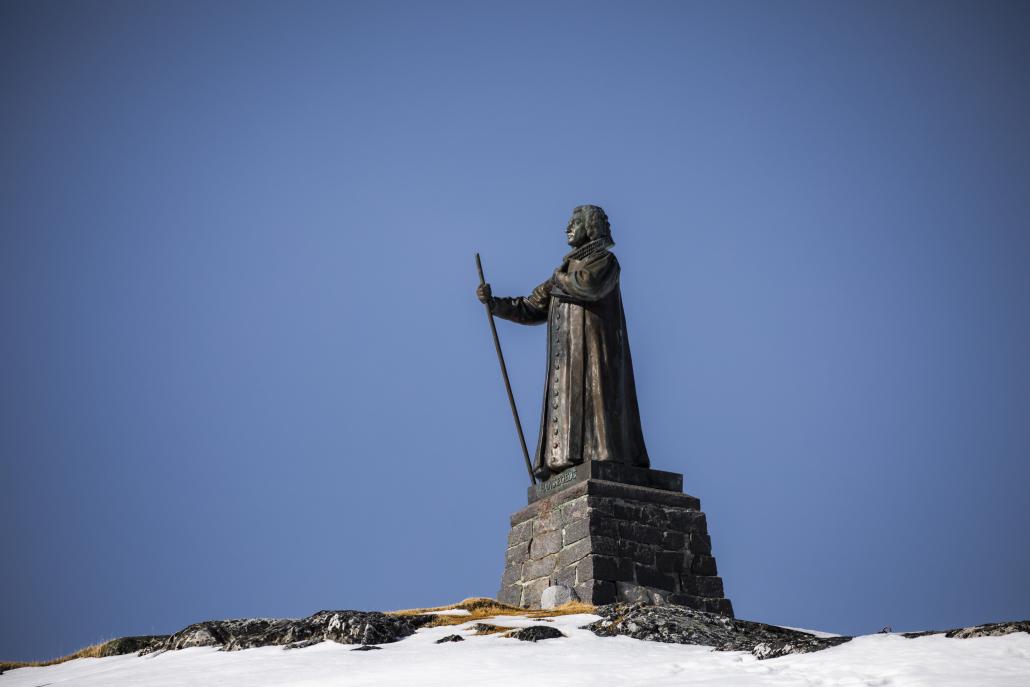This page is part of our “Hidden Figures in Exploration” series, focusing on the contribution of Greenlanders and the Inuit in polar exploration, anthropology, natural science and understanding of the planet’s climate.
The Greenlandic anthropologist Knud Rasmussen, together with his two crew mates, a woman called Arnarulunguak and a young man called Qaavigarsuak, left Greenland in 1921 on his fifth and by far the most ambitious Thule expedition. It was a three years dog sledding expedition across Arctic Canada and Alaska to Eastern Siberia. Here you can find an overview of the expedition, its purpose, achievements and participants. Knud Rasmussen, or Kunuunnguaq as he was called home in Greenland, became a well known man across the Arctic. He conducted a number of expeditions and managed to prove that the Inuit of Greenland, Canada, Alaska and Siberia all have the same origin. Although their way of life differed considerably sometimes according to living conditions, primary prey and way of life, they were all connected through language, mythology and common stories that traced hundreds or even thousands of years back.
History – Timeline
The Fifth Thule Expedition started in Greenland in the summer of 1921 and went on for the following three years until Knud Rasmussen, Arnarulunguak and Qaavigarsuak reached the eastern tip of Siberia in 1924. Here are they main dates during the expedition.
July 9th 1921
Expedition ship Søkongen leaves Nuuk for Ilulissat
July 16th 1921
Mayday received from MS Bele and rescue operation started
July 16th 1921
July 26th 1921
Søkongen leaves Thule
Sept 7th 1921
Søkongen finally leaves Nuuk in Greenland after the crew was hit by serious influenza, killing two crew mates.
Sept 7th 1921
Sept 21st 1921
Søkongen arrives at “Danske øen” in Nunavut, Canada
Sept 24th 1921
Søkongen leaves the crew behind and sails back.
Sept 24th 1921
The Danish King Christian X was in Greenland celebrating the 200 years anniversary of the arrival of the Norwegian/Danish missionary Hans Egede with his royal ship “Island”. On July 16th, while located in Ilulissat, the ship received a Mayday via the first telegram ever sent in this part of Greenland. Bele was stranded. Together with Knud Rasmussen’s ship, Søkongen, they sailed north to rescue the crew and what was salvageable of the cargo.
It wasn’t until September 7th 1921 that the expedition ship finally left Nuuk, the capital of Greenland, and sailed into Hudson Bay and further along to their first destination, a small island they named “Danske øen” (Danish Island) in the Foxe Basin in Nunavut, Canada. They built a base there called “Blæsebelgen” (the Bellow), from where they departed for different expeditions, dividing the work and regions between them. Danish archeologists Kaj Birket-Smith og Therkel Mathiassen would identify several archeological sites and map out different cultures, time periods and migration patterns, laying the theory for what has been called the Thule culture, migrating whale hunters who crossed over to Greenland at around the year 1250. Peter Freuchen focused on cartography and biology while Knud Rasmussen himself focused on the intellectual side of the Inuit living in the region, mapping their culture, traditions and mythology. Born in Ilulissat to a Danish father and a Greenlandic mother and educated in Denmark, Knud Rasmussen was equally fluent in the “white man’s” customs and scientific methods as in Inuit languages and mythology which he grew up with from his mother. This made him perfectly suited for the task ahead.
The Fifth Thule Expedition is a fundamental event in both polar exploration and anthropology. Knud Rasmussen made contact with Inuit populations who had never before had contact with a “white man”, groups where the original religion, customs and mythology was still alive and well, and he managed to map those before they were affected by external influence. The expedition resulted in a number of books, including a ten-volume collection of Inuit myths, thousands of photographs and a film. Their contribution to the understanding of human adaptability to extreme environments, migration patterns and the origin of Greenlanders is invaluable. This expedition was dotted with oddities, such as the igloo where Knud was met with Italian arias, played from a grammophone the Inuk had recently purchased for skins and fur at a Hudson Bay Company outpost; the African girl that he met in the door of another igloo and when he was out of ammunition and winter was coming with bleak prospects for survival a small sail boat from San Francisco suddenly appeared where no boat had been before, with a Dane on board that was willing to give them all the ammunition they would need.
Several museums are dedicated to the great achievements of Knud Rasmussen and his team and many of the amulets and artifacts gathered during the expedition can be found at the national museum in Copenhagen.
Continues further down the page…














